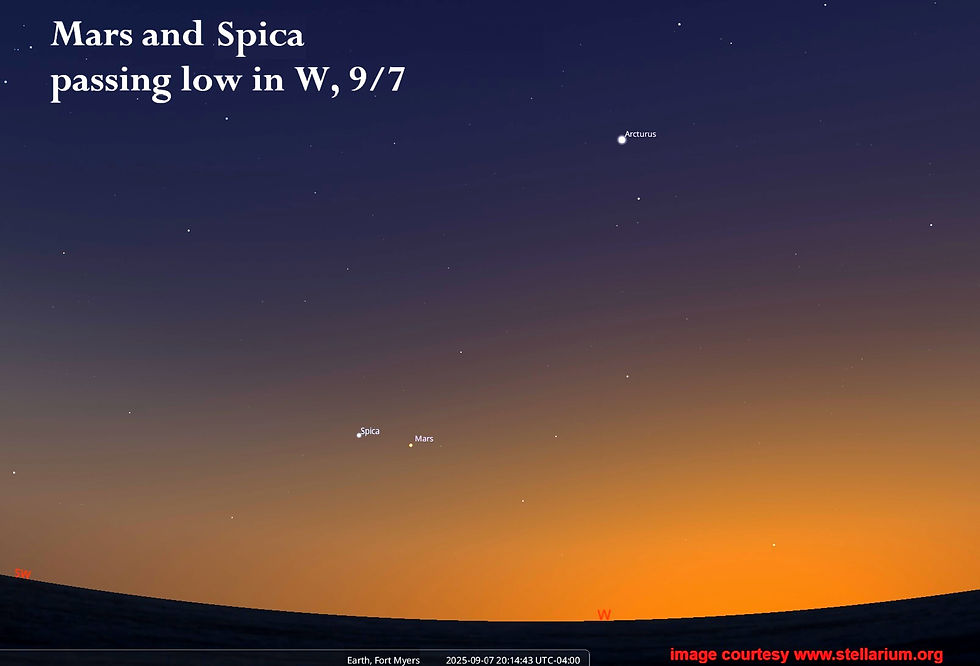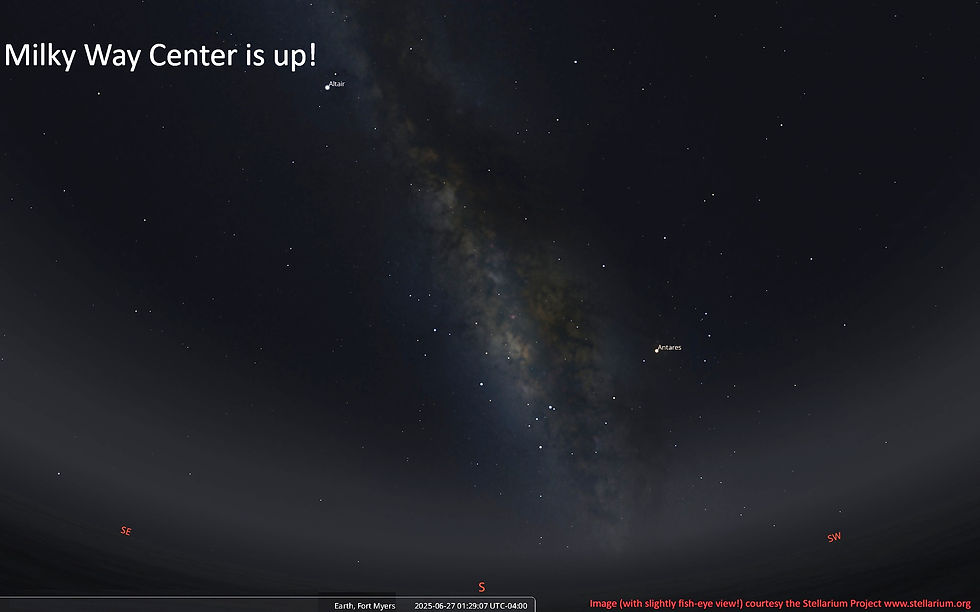What's Up in SWFL Skies: Eclipse Coming! - April 2024
- Cindy Banyai

- Apr 3, 2024
- 6 min read
By: Heather Preston, Planetarium Director

Moon Phases March 2024 (Eastern Time Zone)
1 8 15 23
3Q New 1Q Full Moon
Eclipse Day!
April 8th, two weeks from last month's lunar penumbral eclipse, a TOTAL SOLAR ECLIPSE crosses the United States from Texas to Maine, and here in Fort Myers we will be in the 52% coverage zone at maximum coverage, about 2:59 pm (we will be in the Moon's penumbra -- the Moon's umbra's track is the path of totality). Although CNCP is closed Mondays, on April 8th only here at the planetarium from noon to around 4:15 pm we will have a solar telescope out front (weather permitting), eclipse glasses available (yes, you can buy them ahead of time at the planetarium front desk), shows and live eclipse coverage in the dome (that will run a bit beyond the "last contact time" for the eclipse locally), and cold water available if you get hot being out in the Sun! :-) The final moment of contact is 4:13 pm, after that we will wind up with a final presentation for anyone who missed earlier ones, and we can all go home and eat "eclipse cookies!" After April 8, 2024, the next solar eclipse to cross the contiguous United States will do so in 2044. More details: NASA
Planets
At the start of the month and for the first week, the Moon and Venus, Mars and Saturn will be making pretty displays in the predawn sky! Jupiter and Mercury will be early evening objects - but by month's end, Mercury will have crossed the Sun and become a pre-dawn planet, and Jupiter will be very low/setting in the West at the start of the night.
Venus will be bright in the pre-dawn eastern sky each morning, but it's getting lower, closer to the Sun, and farther north along the horizon -- and it’s going to get a little less bright each day as the month proceeds, so eventually it will be nearly lost in the morning glare (see the image for April 30, below). On the morning of April 7, the extremely thin waning crescent Moon will be right next to Venus, which may look quite nice, depending on the weather. Saturn and Mars will both be above Venus in our pre-dawn eastern sky all month, and Mercury will also be above Venus after the 19th. None will be as bright as Venus, however, so on April 30th around 06:25 they will be nicely spaced out, in a line that shows you the "plane of the solar system" picked out in a string of four of the five naked-eye-visible planets!
Saturn is a faint pre-dawn object, in the east-southeastern sky between bright Venus and also-faint (but reddish) Mars at the start of the month, then passes Mars on April 10th - thereafter Saturn is highest/farthest west of the three.
Jupiter will be the very bright planet in the west at the start of the night all month long. This is the last opportunity for a few months to have a good slice of time to observe our largest and most massive gas giant, so if you do have a telescope, or even really powerful binoculars, take a look!
Stars and the Lyrids Meteor Shower
For the first part of the night, Orion and the entire winter grouping we have already discussed will be medium-high in the West at the start of the month and low in the West by month's end. Leo will be high in the South-Southeast after sunset, and at 1:15 am or so at the start of April and 11:15 pm by the end of April, people looking straight south with no land or shrubs in the way can see all four stars of the Southern Cross at this latitude. Once the bottom star of the Southern Cross sets, you will see a yellow star with a blue star beside it above the south point on your horizon: the yellow star is called Alpha Centauri, our nearest interstellar neighbor! It's actually a triple star system, the component that is closest to us is only 4.2 light years away from our solar system, and that closest component, called Proxima Centauri, has a planet in the "habitable zone," the radius around a star that would support the existence of liquid water on the surface of a terrestrial-style planet. In the pre-dawn hours (fishing trip time!) you will see the "curly J" of Scorpius the Scorpion in the southeastern sky well before dawn, followed by the "teapot" of Sagittarius the Archer just east of and above the scorpion's tail.
The dark hours pre-dawn but after midnight are also the best time to see meteors. April 14 - 29 we will be passing through the densest part of the annual Lyrid meteor shower's debris stream. As NASA mentions, "The pieces of space debris that interact with our atmosphere to create the Lyrids originate from comet C/1861 G1 Thatcher. Comet Thatcher was discovered on April 5, 1861, by A. E. Thatcher." - more at NASA
Vernal Equinox (March Equinox)
On Tuesday, March 19th, at 11:06 pm EDT, the Earth will pass through one of the two symmetrical points on its orbit at which its axial tilt is neither toward nor away from the Sun: the equinoxes! This one, the Vernal Equinox, is used as a "fixed point" in space when calculating orbits for spacecraft and when relating coordinates of astronomical objects. It shifts very, very slowly against the background stars as the Earth goes through its 26,000-year precessional cycle, but for short-term purposes, it's pretty "fixed!" Thus, on the equinoxes, the Sun rises as close to straight East and sets as close to straight West as it's going to get, in its ceaseless back-and-forth from farthest south (Winter, or December, solstice) to farthest north (Summer, or June, solstice) against our horizons.
At the Planetarium
We show four different planetarium shows, two on odd-numbered days and the other two on even-numbered days, so that visitors can attend planetarium shows at 12:15 pm and at 2:15 pm two days in a row and never see the same shows twice. Every Sunday, we have an extra planetarium show with a science discovery emphasis at 3:15 pm. We do a morning "sensory Sunday" show each month, usually on the first Sunday, for people with sensory challenges who want a kid-appropriate show with low volume and a bit more lighting in the planetarium (but please reserve your spot ahead of time for these as they can fill up). We also have at least one special planetarium evening show or presentation at 7 pm (sometimes a show with a talk, too) per month, usually on the evening of the third Wednesday. These are fun and educational and usually related to what is going on that month in our SW Florida skies. Other times we may cover some cool topics in-depth. Our planetarium shows usually have descriptions posted in our calendar. Just click on the individual items for the relevant day in our Calendar to see a full description of the shows or events for that day. You get a "being there" full-surround video and audio experience with all of our shows, and an optional "star walk" guide to our current night sky.
The planetarium presentations are mask-optional -- because you are indoors with other people for about 45 minutes, you might want one, but it's up to you. Planetarium shows are 6 days/week at 12:15 pm and at 2:15 pm (plus an "extra show" at 3:30 pm on Sundays). Please check our Calendar for details. To ensure getting a seat (or the seat you want), please arrive fifteen minutes before the scheduled show time (in "season" especially). We do have two hand sanitizer stations in the lobby, and we thank you for helping us keep everyone safe by distancing, wearing your masks if you have reason to throughout the show and using the sanitizer upon entry. Thank you!
Our friends at the SW Florida Astronomical Society's regular first-Thursday "Meetings with Speaker Series" are hybrid live and Zoom meetings for now (Zoom portion needs to be arranged in advance, see their website for contact info and updates: www.theEyepiece.org). Some of the members are discovering that being able to attend SWFAS from anywhere in the world is actually pretty convenient! Some of the speakers are pretty famous -- how does SWFAS manage that? Well the speakers, too, can Zoom if needed! Occasionally they will have a free planetarium show instead of a speaker, so check their website!
To get a printable (black on white, saves ink) map of the night sky (note: N-S-E-W directions will only make sense if you hold the map overhead to look at it), visit the free download site of the AWESOME skymaps.com.
To spot the International Space Station moving through your sky, try NASA's Spot The Station website! Or to add in the Hubble and various other bright satellites, you can try Sky & Telescope's Tracker page. Or Satflare, of course.
Visit the Planetarium for updates on all of our space-related wonders! You can even rent the planetarium, for your own space-themed party, wedding, celebration of life, meeting, meditation session, or other cosmic event. If you have guests who are immunocompromised, please don't forget the masks, though, whether regular or space-themed.
Hope to see you soon at the Center!





Comments